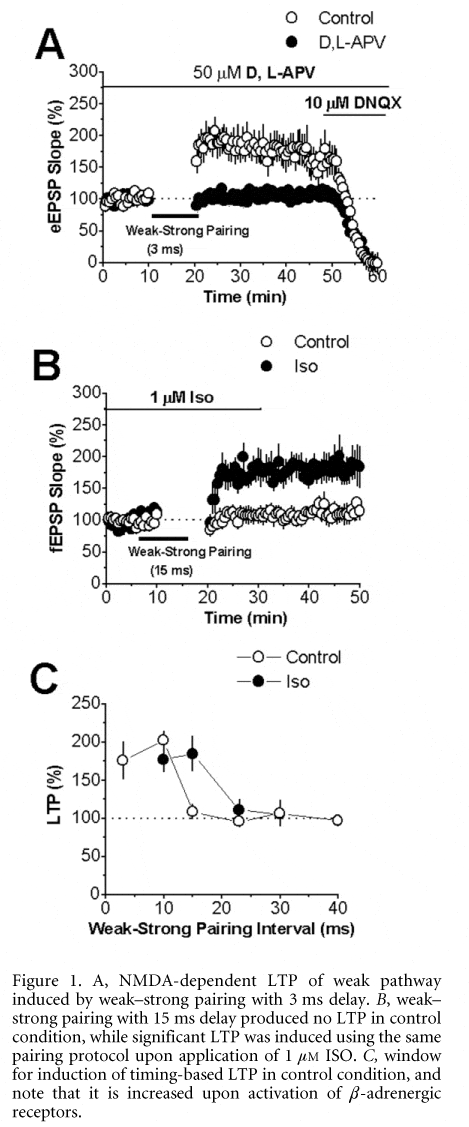Although activation of β-adrenergic receptors has been reported to enhance homosynaptic plasticity at hippocampal CA1 synapses (Katsuki et al. 1997), its role in modulating the timing-based heterosynaptic plasticity received less attention. We therefore wish to address this issue in this study. Male Sprague-Dawley rats (100Ð150 g) were killed by cervical dislocation in accordance with the guidelines of local ethical committee for animal studies, and transverse hippocampal slices (450 mm) obtained. A recording pipette filled with 3 M NaCl was placed in stratum radiatum of the CA1 area; on both sides, two stimulating electrodes were positioned to recruit two separate Schaffer collateral pathways. The intensity of stimulation was adjusted to elicit 30Ð40 % of maximum response at one (weak) pathway and 80Ð90 % at the other (strong) pathway. Data are expressed as means ± S.E.M. and significance was tested using a paired t test.
Baseline fEPSPs of the weak pathway were evoked every 30 s for at least 10 min, and LTP of this pathway was induced by pairing the weak stimulus with the strong pathway, the weak pathway leading by 3 to 40 ms, for 100 times at 0.167 Hz. As can be seen in Fig. 1, weakÐstrong pairing with 3 and 10 ms delay could respectively induce LTP of 176 ± 24 % (P < 0.001, n = 6, Fig. 1A) and 202 ± 15 % (P < 0.001, n = 6; Fig. 1C). This form of LTP was NMDA dependent, as 50 mM D,L-APV blocked its induction (106 ± 6.5 %, n = 6; Fig. 1A). However, no LTP was observed if the weakÐstrong pairing delay was longer than 15 ms (Fig. 1C). Bath application of 1 mM isoproterenol (ISO) together with pairing of 15 ms delay, a protocol that produced no LTP in control conditions (109 ± 9.2 %, n = 6; Fig. 1B), resulted in LTP (185 ± 22 %, P < 0.001, n = 6). Application of ISO had no effect on the magnitude of LTP induced by pairing with 10 ms delay (177 ± 18 %, n = 6, ANOVA test). Taken together, the above results suggested that the window for timing-based LTP induction at CA1 synapses is of about 3Ð10 ms (see also Bi & Poo, 1998). Activation of β-adrenergic receptors could enhance timing based LTP by increasing the window for its induction rather than its magnitude.
This work was supported by NSC and CMC Hospital.
All procedures accord with current local guidelines.

